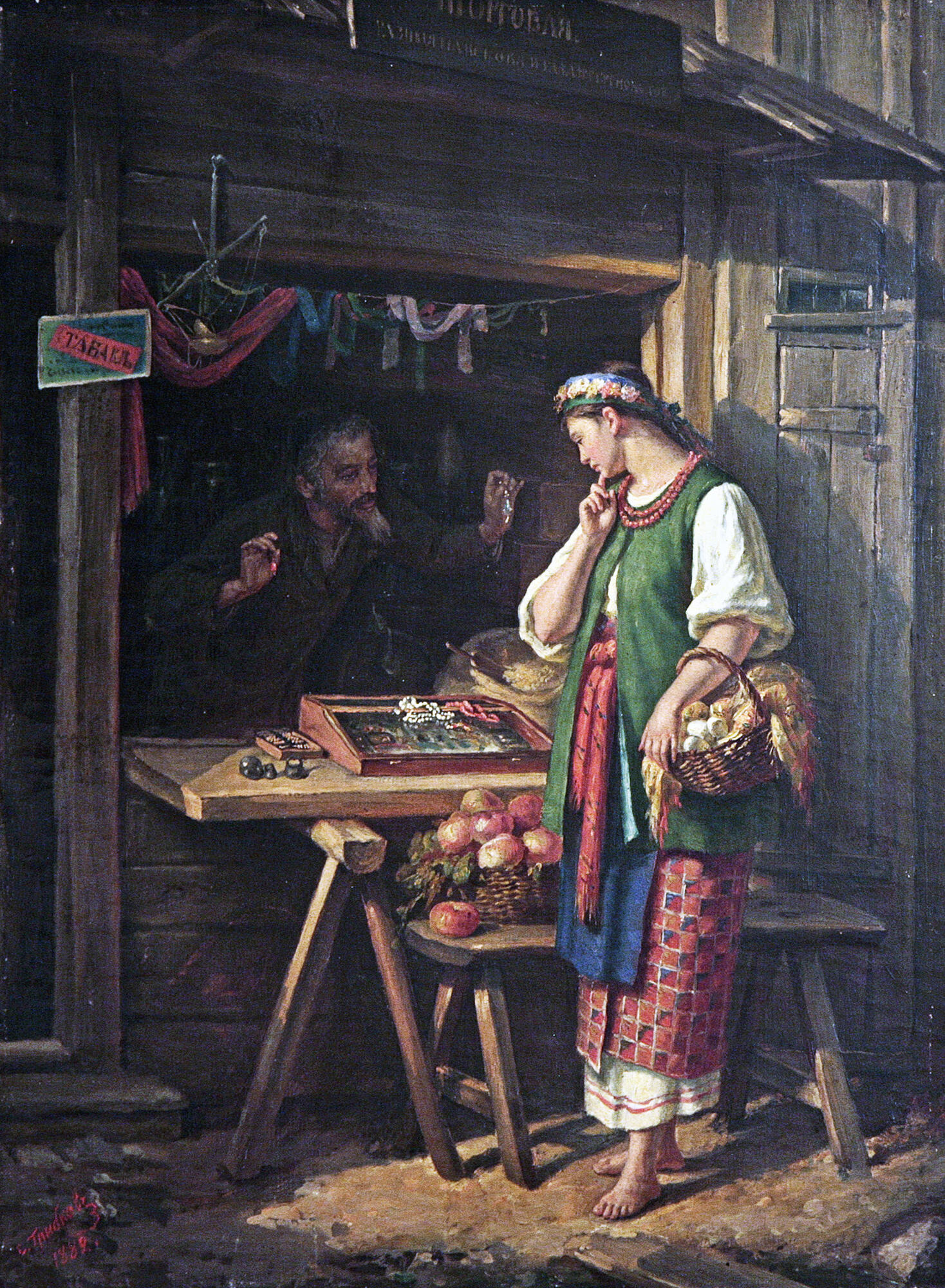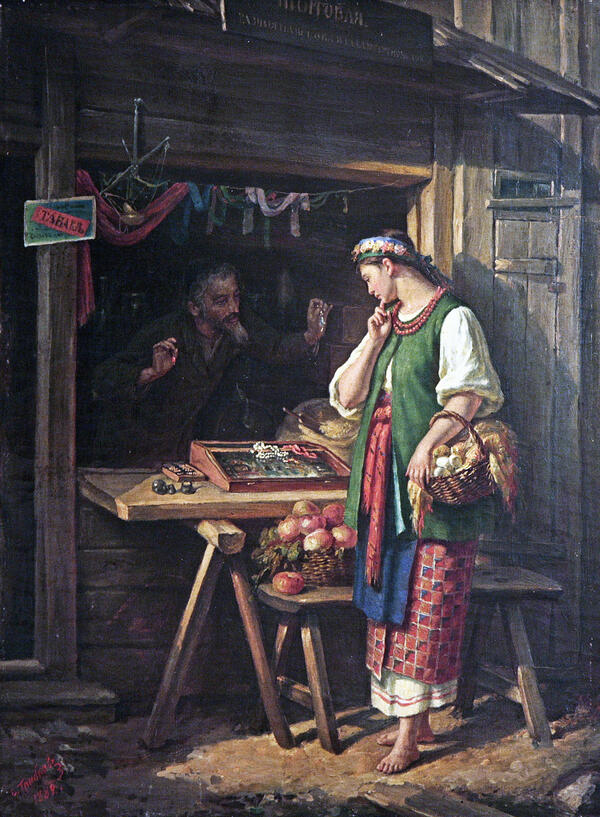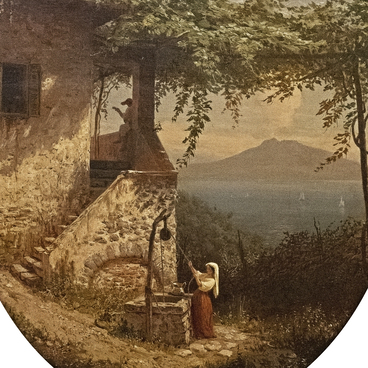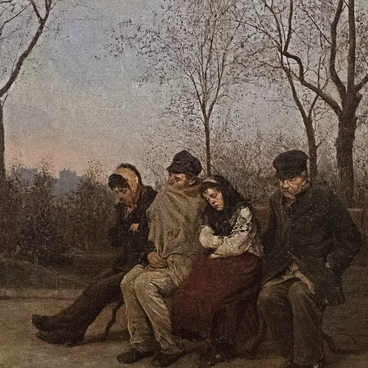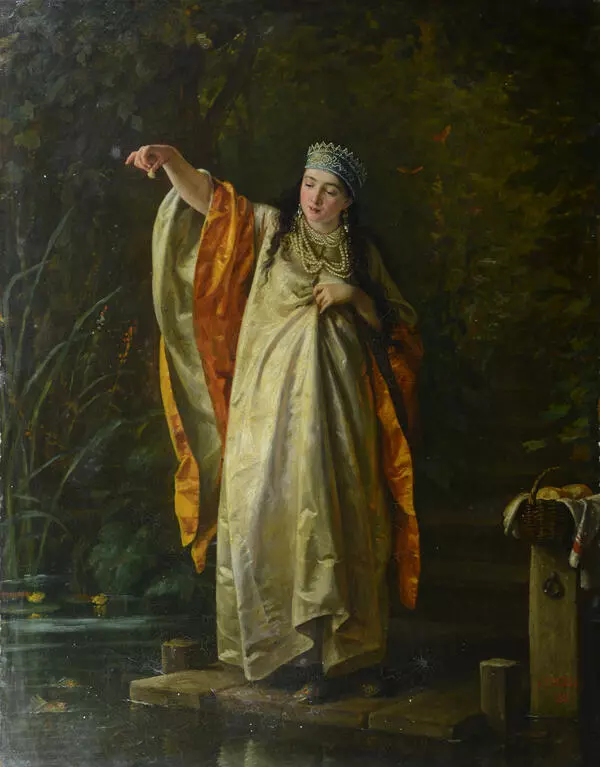Sergei Gribkov is a Russian artist of the second half of the 19th century, a master of genre and history painting, portrait art and temple murals.
Gribkov earned renown as a painter of everyday scenes. Though small-scale, his works were filled with the dynamics of everyday life and opened a new stage in the development of Russian genre painting.
Gribkov painted ‘In the Shop’ in the late creative period of his life. The painting belongs to the so-called ‘eventless’ everyday genre. There is no complex plot in the picture; alternatively, Gribkov focuses on the simplicity and verisimilitude of the composition.
A village girl stopped at an open jewelry shop, looking at the ornaments that are too expensive for her. She is dressed in a bright-colored decorative traditional costume of Little Russia (the modern-day territories of Ukraine). The girl came to the town fair in order to sell the apples, which fill her baskets.
The color scheme creates harmony in the painting — with dense pink, blue, green and white spots immersed in a general calm brown-ocher tone. Gribkov managed to convey in detail the very texture and tangibility of the objects we observe — the jewelry sparkles in the sunlight, the fabrics are soft and loose, the crisp apples are ripe with juice.
The girl’s sad face, her pensive posture, the look that she does not take away from the jewelry — all these features vividly convey her thoughts and feelings. Gribkov uses these details to reveal the girl’s inner state of mind and evoke the viewer’s sympathy and compassion.
The artist’s distinctive talent was his ability to portray people’s feelings and desires in such a way that the viewer comprehends them easily. The painter avoids excessive tension and drama, the scenes of everyday life lack conflict. The paintings capture the lives of ordinary people with their sorrows and joys.
Although Gribkov took up painting quite late, he was a prolific artist and executed several dozen paintings, achieving success and recognition by the public and critics.
Thus, in 1852, Gribkov was awarded the title of non-class history painting artist, but he continued his studies. He graduated from the Moscow School of Painting, Sculpture and Architecture only in 1856. After graduation, he lived and worked in Moscow. For many years, Gribkov ran an art workshop, where he gave shelter to beginner artists.
Gribkov earned renown as a painter of everyday scenes. Though small-scale, his works were filled with the dynamics of everyday life and opened a new stage in the development of Russian genre painting.
Gribkov painted ‘In the Shop’ in the late creative period of his life. The painting belongs to the so-called ‘eventless’ everyday genre. There is no complex plot in the picture; alternatively, Gribkov focuses on the simplicity and verisimilitude of the composition.
A village girl stopped at an open jewelry shop, looking at the ornaments that are too expensive for her. She is dressed in a bright-colored decorative traditional costume of Little Russia (the modern-day territories of Ukraine). The girl came to the town fair in order to sell the apples, which fill her baskets.
The color scheme creates harmony in the painting — with dense pink, blue, green and white spots immersed in a general calm brown-ocher tone. Gribkov managed to convey in detail the very texture and tangibility of the objects we observe — the jewelry sparkles in the sunlight, the fabrics are soft and loose, the crisp apples are ripe with juice.
The girl’s sad face, her pensive posture, the look that she does not take away from the jewelry — all these features vividly convey her thoughts and feelings. Gribkov uses these details to reveal the girl’s inner state of mind and evoke the viewer’s sympathy and compassion.
The artist’s distinctive talent was his ability to portray people’s feelings and desires in such a way that the viewer comprehends them easily. The painter avoids excessive tension and drama, the scenes of everyday life lack conflict. The paintings capture the lives of ordinary people with their sorrows and joys.
Although Gribkov took up painting quite late, he was a prolific artist and executed several dozen paintings, achieving success and recognition by the public and critics.
Thus, in 1852, Gribkov was awarded the title of non-class history painting artist, but he continued his studies. He graduated from the Moscow School of Painting, Sculpture and Architecture only in 1856. After graduation, he lived and worked in Moscow. For many years, Gribkov ran an art workshop, where he gave shelter to beginner artists.
